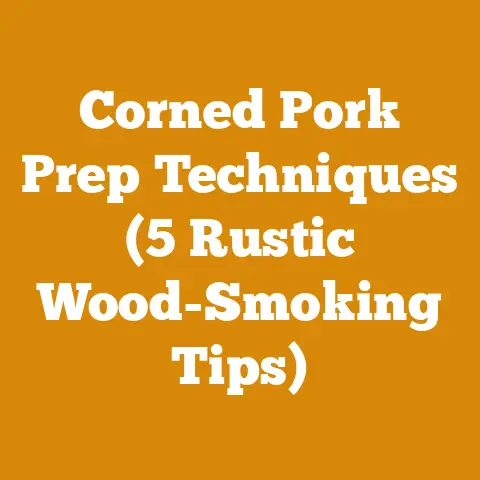Top Load Boiler Essentials for Firewood Prep (7 Pro Hacks)
I still remember the bone-chilling winters of my youth, where the only thing standing between us and the relentless cold was a roaring fire fueled by the wood I helped my grandfather chop. Back then, firewood wasn’t just a chore; it was a lifeline. And our old top load boiler? It was the heart of our home, demanding the best wood we could provide. Through the years, I’ve learned a thing or two about preparing firewood specifically for these hungry beasts, and I’m here to share those hard-earned lessons with you. This isn’t just about chopping wood; it’s about optimizing your fuel source for efficiency, safety, and long-term cost savings. Let’s dive into the seven pro hacks that will revolutionize your firewood prep for top load boilers.
I’ve seen firsthand how the wrong choice can lead to wasted energy, increased creosote buildup, and even damage to the boiler itself.
The BTU Battle: The key is understanding British Thermal Units (BTUs), the measure of heat energy in wood. Hardwoods like oak, maple, and ash pack a serious BTU punch, offering more heat per volume than softwoods like pine or fir. For instance, a cord of seasoned oak can deliver around 24 million BTUs, while a cord of pine might only give you 15 million BTUs. That’s a significant difference!
Data-Backed Insight: According to the U.S. Department of Energy, using hardwoods can reduce your overall wood consumption by up to 30% compared to softwoods, translating to significant cost savings over a heating season.
My Experience: I once tried to save a few bucks by burning a lot of pine I got for cheap. Big mistake! I was constantly feeding the boiler, and the creosote buildup was a nightmare. After that, I stuck to oak and maple.
The Creosote Factor: Softwoods tend to have higher resin content, which leads to increased creosote formation in your chimney. Creosote is a highly flammable substance that can cause chimney fires. Regular chimney cleaning is essential, but choosing the right wood can minimize this risk.
Pro Tip: Create a wood species chart specific to your region. Note the BTU rating, drying time, and creosote potential of each species. This will become your go-to guide for firewood selection.
Actionable Takeaway: Research the BTU content and creosote potential of wood species available in your area. Prioritize hardwoods for maximum efficiency and safety.
Hack #2: The Drying Game: Seasoning for Success
Seasoning, or drying, firewood is arguably the most crucial step in the entire process. Green wood contains a high moisture content (often over 50%), which significantly reduces its heating efficiency and increases creosote production.
The Science of Seasoning: As wood dries, the moisture evaporates, increasing its BTU content and making it easier to ignite and burn cleanly. Properly seasoned wood should have a moisture content of 20% or less.
Data-Backed Insight: A study by the Biomass Energy Resource Center found that burning seasoned wood can increase heating efficiency by up to 40% compared to burning green wood.
My Experience: I once rushed the seasoning process and tried to burn wood that was only partially dry. It was a smoky, inefficient mess. The fire was sluggish, and the house barely warmed up. It was a lesson learned the hard way.
The Time Factor: The drying time varies depending on the wood species, climate, and how the wood is stacked. Generally, hardwoods take longer to season than softwoods. A good rule of thumb is to season firewood for at least six months, but a year is even better.
The Stacking Strategy: Proper stacking is crucial for effective seasoning. Stack the wood off the ground on pallets or timbers to allow for air circulation. Leave gaps between the rows to further promote airflow. Orient the stack so that it is exposed to sunlight and wind.
Pro Tip: Use a moisture meter to accurately measure the moisture content of your firewood. This will eliminate guesswork and ensure that your wood is properly seasoned.
Actionable Takeaway: Invest in a moisture meter and use it regularly to monitor the seasoning process. Aim for a moisture content of 20% or less before burning.
Too large, and the wood won’t burn efficiently. Too small, and it will burn too quickly.
The Ideal Dimensions: Generally, firewood for top load boilers should be split into pieces that are 16-20 inches long and 4-6 inches in diameter. This size allows for optimal airflow and combustion within the firebox.
My Experience: I used to just split wood haphazardly, without paying much attention to size. I realized that consistently sized pieces burned much more evenly and efficiently.
The Boiler’s Blueprint: Consult your boiler’s manual for specific recommendations on firewood size. Some boilers may have different requirements based on their design and capacity.
The Splitting Strategy: Use a hydraulic log splitter to efficiently split firewood into the desired dimensions. A good splitter will save you time and energy, especially when dealing with large quantities of wood. I prefer a 25-ton splitter for most jobs.
Data-Backed Insight: A study by the University of Maine found that consistently sized firewood burned more efficiently and produced less smoke than irregularly sized pieces.
Pro Tip: Create a jig or template to ensure consistent firewood size. This will streamline the splitting process and improve your overall efficiency.
Actionable Takeaway: Measure your boiler’s firebox and determine the optimal firewood size. Use a jig or template to ensure consistent dimensions.
Hack #4: Mastering the Split: Techniques for Efficient Processing
The way you split your firewood can significantly impact its drying time and burning efficiency.
The Quarter Split: For most hardwoods, splitting the wood into quarters is ideal. This exposes more surface area to the air, accelerating the drying process.
The Kindling Conundrum: Don’t forget to prepare plenty of kindling. Small, dry pieces of wood are essential for starting a fire quickly and efficiently. I like to split small pieces of softwood into thin strips for kindling.
My Experience: I used to struggle to start fires, especially with damp wood. Then I started paying more attention to kindling, and it made a world of difference.
The Knotty Nightmare: Knots in wood can make splitting difficult and dangerous. Use a splitting maul or a hydraulic splitter to handle knotty pieces. Always wear safety glasses and gloves when splitting wood.
Data-Backed Insight: According to the National Safety Council, wood splitting is a leading cause of injuries related to firewood preparation. Always use appropriate safety equipment and techniques.
The Wedge Wisdom: For particularly tough or knotty pieces, use a splitting wedge in conjunction with a sledgehammer. Drive the wedge into the wood along the grain to split it open.
Pro Tip: Sharpen your splitting tools regularly. A sharp axe or maul will make splitting easier and safer.
Actionable Takeaway: Practice different splitting techniques to find what works best for you and your wood. Always prioritize safety when splitting wood.
Hack #5: Storage Solutions: Protecting Your Precious Fuel
Proper storage is essential for keeping your firewood dry and protected from the elements.
The Elevated Approach: Store your firewood off the ground on pallets or timbers to prevent moisture from wicking up from the soil.
The Covered Canopy: Cover your firewood pile with a tarp or a shed roof to protect it from rain and snow. Make sure to leave the sides open to allow for ventilation.
My Experience: I once left a pile of firewood uncovered during a heavy rainstorm. It took weeks to dry out, and some of it even started to rot.
The Pest Prevention: Inspect your firewood regularly for signs of pests, such as termites or carpenter ants. If you find any, take steps to control them before they infest your home.
Data-Backed Insight: According to the USDA Forest Service, improper firewood storage can lead to significant wood decay and loss of BTU content.
The Location Logistics: Choose a storage location that is convenient to your boiler but also far enough away from your house to minimize the risk of pests or fire.
Pro Tip: Use a firewood rack to keep your firewood organized and off the ground.
Actionable Takeaway: Invest in a proper firewood storage system to protect your fuel from the elements and pests.
Hack #6: Safety First: Gear and Practices for Injury Prevention
Firewood preparation can be dangerous if proper safety precautions are not taken.
The Gear Guide: Always wear safety glasses, gloves, and sturdy footwear when handling firewood. Consider wearing ear protection if you are using a chainsaw or log splitter.
The Chainsaw Checklist: If you are using a chainsaw, make sure it is in good working condition and that you are properly trained in its use. Always wear a helmet with a face shield and chaps.
My Experience: I once had a close call when a piece of wood kicked back while I was using a chainsaw. Fortunately, I was wearing safety glasses and chaps, which prevented serious injury.
The Lifting Logistics: Use proper lifting techniques to avoid back injuries. Bend your knees, keep your back straight, and lift with your legs.
Data-Backed Insight: According to the Centers for Disease Control and Prevention (CDC), back injuries are a common cause of lost workdays in the logging and firewood industries.
The First Aid Fundamentals: Keep a well-stocked first aid kit on hand in case of injuries. Know how to treat common injuries, such as cuts, splinters, and burns.
Pro Tip: Take regular breaks to avoid fatigue. Fatigue can increase the risk of accidents.
Actionable Takeaway: Prioritize safety by wearing appropriate gear, using proper techniques, and taking regular breaks.
Hack #7: The Long Game: Sustainable Firewood Management
Firewood is a renewable resource, but it’s important to manage it sustainably to ensure that it is available for future generations.
The Selective Harvest: When harvesting firewood, choose trees that are dead, dying, or diseased. This will improve the health of the forest and provide you with a sustainable source of fuel.
The Reforestation Route: Consider planting new trees to replace the ones you harvest. This will help to ensure that the forest remains healthy and productive.
My Experience: I’ve started planting a few trees each year to replace the ones I’ve harvested for firewood. It’s a small effort, but it makes a difference.
The Sustainable Sourcing: If you are purchasing firewood, choose a supplier that practices sustainable forestry. Look for certifications such as the Forest Stewardship Council (FSC).
Data-Backed Insight: According to the World Wildlife Fund (WWF), sustainable forestry practices can help to protect forests, biodiversity, and water resources.
The Conservation Commitment: Conserve firewood by burning it efficiently and using other sources of heat when possible.
Pro Tip: Consider using a wood stove or fireplace insert to improve the efficiency of your wood burning.
Actionable Takeaway: Practice sustainable firewood management by harvesting selectively, replanting trees, and conserving fuel.
By implementing these seven pro hacks, you’ll not only be preparing firewood more efficiently for your top load boiler, but you’ll also be saving money, increasing safety, and contributing to a more sustainable future. Remember, firewood preparation is a process, not a race. Take your time, learn from your mistakes, and enjoy the warmth and comfort that a well-fed top load boiler can provide. Happy chopping!






